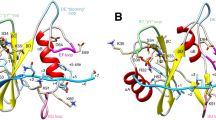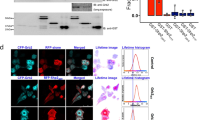Abstract
MANY intracellular targets of protein-tyrosine kinases possess Src homology 2 (SH2) domains that directly recognize phosphotyrosine-containing sites on autophosphorylated growth factor receptors and cytoplasmic proteins, and thereby mediate the activation of biochemical signalling pathways1–7. SH2 domains possess relatively well conserved residues that form the phosphotyrosine-binding pocket8–11, and more variable residues that are implicated in determining binding specificity by recognition of the three amino acids carboxy-terminal to phosphotyrosine (the +1 to +3 positions) 5,7,12,13. One such residue, occupying the EF1 position of the +3-binding pocket, is a Thr in the SH2 domain of the Src tyrosine kinase12, but is predicted to be a Trp in the SH2 domain of the Sem-5/drk/Grb2 adaptor protein5. Here we report that changing this residue in the Src SH2 domain from Thr to Trp switches its selectivity to resemble that of the Sem-5/drk/Grb2 SH2 domain. Furthermore, this mutant Src SH2 domain effectively substitutes for the SH2 domain of the Sem-5 protein in activation of the Ras pathway in vivo. These results identify a residue that can modify SH2 selectivity, and indicate that the biological activity of an SH2 domain correlates with its binding specificity.
This is a preview of subscription content, access via your institution
Access options
Subscribe to this journal
Receive 51 print issues and online access
$199.00 per year
only $3.90 per issue
Buy this article
- Purchase on Springer Link
- Instant access to full article PDF
Prices may be subject to local taxes which are calculated during checkout
Similar content being viewed by others
References
Anderson, D. et al. Science 250, 979–982 (1990).
Pawson, T. & Gish, G. Cell 71, 359–362 (1992).
Cantley, L. C. et al. Cell 64, 281–302 (1991).
Pawson, T. & Schlessinger, J. J. curr. Biol. 3, 434–442 (1993).
Songyang, Z. et al. Cell 72, 767–778 (1993).
Matsuda, M., Mayer, B. J., Fukui, Y. & Hanafusa, H. Science 248, 1537–1539 (1990).
Fantl, W. J. et al. Cell 69, 413–423 (1992).
Koch, C. A., Anderson, D., Moran, M. F., Ellis, C. & Pawson, T. Science 252, 668–674 (1991).
Mayer, B. J., Jackson, P. K. & Baltimore, D. Proc. natn. Acad. Sci. U.S.A. 88, 627–631 (1991).
Marengere, L. E. M. & Pawson, T. J. biol. Chem. 267, 22779–22786 (1992).
Waksman, G. et al. Nature 358, 646–653 (1992).
Waksman, G., Shoelson, S., Pant, N., Cowburn, D. & Kuriyan, J. Cell 72, 779–790 (1993).
Eck, M. I., Shoelson, S. E. & Harrison, S. C. Nature 362, 87–91 (1993).
Clark, S. G., Stern, M.J. & Horvitz, H. R. Nature 356, 340–344 (1992).
Olivier, J. P. et al. Cell 73, 179–191 (1993).
Simon, L. A., Dodson, G. S. & Rubin, G. M. Cell 73, 169–177 (1993).
Lowenstein, E. J. et al. Cell 70, 431–442 (1992).
Songyang, Z. et al. Molec. cell. Biol. 14, 2777–2730 (1994).
Stern, M. J. et al. Molec. Biol. Cell 4, 1175–1188 (1993).
Rozakis-Adcock, M. et al. Nature 360, 689–692 (1992).
Rozakis-Adcock, M., Fernley, R., Wade, J., Pawson, T. & Bowtell, D. Nature 363, 83–85 (1993).
Li, N. et al. Nature 363, 85–88 (1993).
Pelicci, G. et al. Cell 70, 93–104 (1992).
Pendergast, A. M. et al. Cell 75, 175–185 (1993).
Puil, L. et al. EMB0 J. 13, 764–773 (1994).
Schaller, M. D. et al. Proc. natn. Acad. Sci. U.S.A. 89, 5192–5196 (1992).
Hanks, S. K., Calalb, M. B., Harper, M. C. & Patel, S. K. Proc. natn. Acad. Sci. U.S.A. 89, 8487–8491 (1992).
Cobb, B. S., Schaller, M.D., Leu, T-H. & Parsons, J. T. Molec. cell Biol. 14, 147–155 (1994).
Schaller, M. D. et al. Molec. ceil. Biol. 14, 1680–1688 (1994).
Pascal, S. et al. Cell 77, 461–472 (1994).
Felder, S. et al. Molec. cell Biol. 13, 1449–1455 (1993).
Author information
Authors and Affiliations
Rights and permissions
About this article
Cite this article
Marengere, L., Songyang, Z., Gish, G. et al. SH2 domain specificity and activity modified by a single residue. Nature 369, 502–505 (1994). https://doi.org/10.1038/369502a0
Received:
Accepted:
Issue Date:
DOI: https://doi.org/10.1038/369502a0
This article is cited by
-
GRB2 dimerization mediated by SH2 domain-swapping is critical for T cell signaling and cytokine production
Scientific Reports (2023)
-
Comprehensive binary interaction mapping of τ phosphotyrosine sites with SH2 domains in the human genome: Implications for the rational design of self-inhibitory phosphopeptides to target τ hyperphosphorylation signaling in Alzheimer’s Disease
Amino Acids (2022)
-
The dynamics of free and phosphopeptide-bound Grb2-SH2 reveals two dynamically independent subdomains and an encounter complex with fuzzy interactions
Scientific Reports (2020)
-
Non-histone protein methylation as a regulator of cellular signalling and function
Nature Reviews Molecular Cell Biology (2015)
-
A multiscale statistical mechanical framework integrates biophysical and genomic data to assemble cancer networks
Nature Genetics (2014)
Comments
By submitting a comment you agree to abide by our Terms and Community Guidelines. If you find something abusive or that does not comply with our terms or guidelines please flag it as inappropriate.



